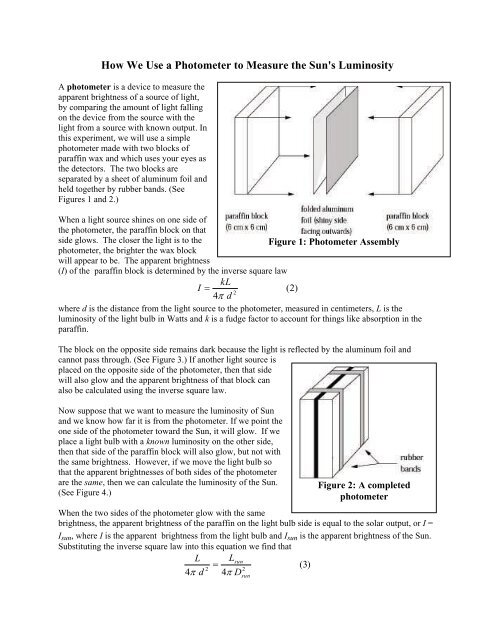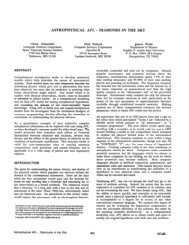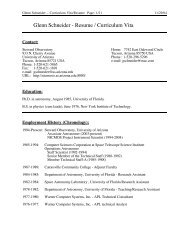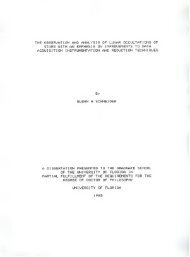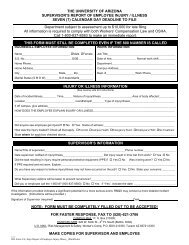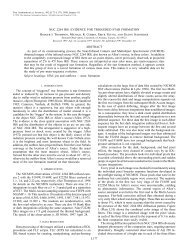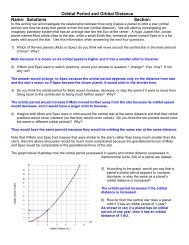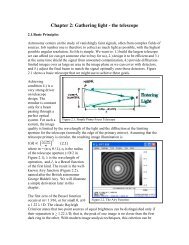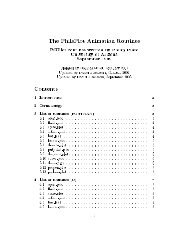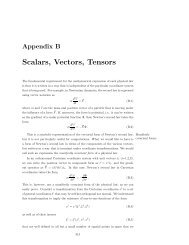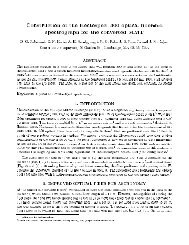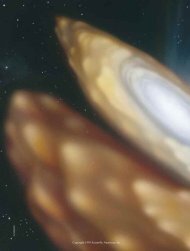How We Use a Photometer to Measure the Sun's Luminosity
How We Use a Photometer to Measure the Sun's Luminosity
How We Use a Photometer to Measure the Sun's Luminosity
Create successful ePaper yourself
Turn your PDF publications into a flip-book with our unique Google optimized e-Paper software.
<strong>How</strong> <strong>We</strong> <strong>Use</strong> a <strong>Pho<strong>to</strong>meter</strong> <strong>to</strong> <strong>Measure</strong> <strong>the</strong> <strong>Sun's</strong> <strong>Luminosity</strong><br />
A pho<strong>to</strong>meter is a device <strong>to</strong> measure <strong>the</strong><br />
apparent brightness of a source of light,<br />
by comparing <strong>the</strong> amount of light falling<br />
on <strong>the</strong> device from <strong>the</strong> source with <strong>the</strong><br />
light from a source with known output. In<br />
this experiment, we will use a simple<br />
pho<strong>to</strong>meter made with two blocks of<br />
paraffin wax and which uses your eyes as<br />
<strong>the</strong> detec<strong>to</strong>rs. The two blocks are<br />
separated by a sheet of aluminum foil and<br />
held <strong>to</strong>ge<strong>the</strong>r by rubber bands. (See<br />
Figures 1 and 2.)<br />
When a light source shines on one side of<br />
<strong>the</strong> pho<strong>to</strong>meter, <strong>the</strong> paraffin block on that<br />
side glows. The closer <strong>the</strong> light is <strong>to</strong> <strong>the</strong><br />
Figure 1: <strong>Pho<strong>to</strong>meter</strong> Assembly<br />
pho<strong>to</strong>meter, <strong>the</strong> brighter <strong>the</strong> wax block<br />
will appear <strong>to</strong> be. The apparent brightness<br />
(I) of <strong>the</strong> paraffin block is determined by <strong>the</strong> inverse square law<br />
kL<br />
I <br />
(2)<br />
2<br />
4<br />
d<br />
where d is <strong>the</strong> distance from <strong>the</strong> light source <strong>to</strong> <strong>the</strong> pho<strong>to</strong>meter, measured in centimeters, L is <strong>the</strong><br />
luminosity of <strong>the</strong> light bulb in Watts and k is a fudge fac<strong>to</strong>r <strong>to</strong> account for things like absorption in <strong>the</strong><br />
paraffin.<br />
The block on <strong>the</strong> opposite side remains dark because <strong>the</strong> light is reflected by <strong>the</strong> aluminum foil and<br />
cannot pass through. (See Figure 3.) If ano<strong>the</strong>r light source is<br />
placed on <strong>the</strong> opposite side of <strong>the</strong> pho<strong>to</strong>meter, <strong>the</strong>n that side<br />
will also glow and <strong>the</strong> apparent brightness of that block can<br />
also be calculated using <strong>the</strong> inverse square law.<br />
Now suppose that we want <strong>to</strong> measure <strong>the</strong> luminosity of Sun<br />
and we know how far it is from <strong>the</strong> pho<strong>to</strong>meter. If we point <strong>the</strong><br />
one side of <strong>the</strong> pho<strong>to</strong>meter <strong>to</strong>ward <strong>the</strong> Sun, it will glow. If we<br />
place a light bulb with a known luminosity on <strong>the</strong> o<strong>the</strong>r side,<br />
<strong>the</strong>n that side of <strong>the</strong> paraffin block will also glow, but not with<br />
<strong>the</strong> same brightness. <strong>How</strong>ever, if we move <strong>the</strong> light bulb so<br />
that <strong>the</strong> apparent brightnesses of both sides of <strong>the</strong> pho<strong>to</strong>meter<br />
are <strong>the</strong> same, <strong>the</strong>n we can calculate <strong>the</strong> luminosity of <strong>the</strong> Sun.<br />
(See Figure 4.)<br />
When <strong>the</strong> two sides of <strong>the</strong> pho<strong>to</strong>meter glow with <strong>the</strong> same<br />
brightness, <strong>the</strong> apparent brightness of <strong>the</strong> paraffin on <strong>the</strong> light bulb side is equal <strong>to</strong> <strong>the</strong> solar output, or I =<br />
I sun , where I is <strong>the</strong> apparent brightness from <strong>the</strong> light bulb and I sun is <strong>the</strong> apparent brightness of <strong>the</strong> Sun.<br />
Substituting <strong>the</strong> inverse square law in<strong>to</strong> this equation we find that<br />
L Lsun<br />
<br />
(3)<br />
2<br />
2<br />
4<br />
d 4<br />
D<br />
sun<br />
Figure 2: A completed<br />
pho<strong>to</strong>meter
where L and L sun are <strong>the</strong> luminosities of <strong>the</strong> light bulb and <strong>the</strong> Sun, respectively, and d and D sun are <strong>the</strong><br />
distances of <strong>the</strong>se two sources from<br />
<strong>the</strong> pho<strong>to</strong>meter. Assuming <strong>the</strong><br />
paraffin blocks on ei<strong>the</strong>r side of <strong>the</strong><br />
aluminum foil are similar, <strong>the</strong> fudge<br />
fac<strong>to</strong>r, k, cancels out. <strong>We</strong> already<br />
know L and D sun , and we can<br />
measure d, so this equation can be<br />
manipulated <strong>to</strong> give <strong>the</strong> luminosity<br />
of <strong>the</strong> Sun, L sun .<br />
The experiment works better if <strong>the</strong><br />
paraffin block is partially<br />
surrounded by a baffle <strong>to</strong> keep stray<br />
sunlight from reaching it. You can<br />
use pieces of black cardboard <strong>to</strong><br />
make a baffle, as indicated in Figure 4.<br />
Figure 3. The side of <strong>the</strong> paraffin facing <strong>the</strong> light glows.<br />
Figure 4. Comparing <strong>the</strong> brightness of <strong>the</strong> Sun <strong>to</strong> a 300-Watt light bulb.
NatSci102 (Prof. Rieke)<br />
Name__________________<br />
This sheet is <strong>to</strong> be turned in along with <strong>the</strong> rest of <strong>the</strong> homework assignment.<br />
Measuring <strong>the</strong> <strong>Sun's</strong> <strong>Luminosity</strong><br />
1. Each group of students will be given a 300-watt bulb, an extension cord, a pho<strong>to</strong>meter, a ruler, and a<br />
large piece of black poster board.<br />
2. Plug in <strong>the</strong> bulb and turn it on.<br />
3. Hold <strong>the</strong> pho<strong>to</strong>meter between <strong>the</strong> Sun and <strong>the</strong> bulb with <strong>the</strong> bulb's filament parallel <strong>to</strong> <strong>the</strong> face of <strong>the</strong><br />
pho<strong>to</strong>meter. Hold <strong>the</strong> o<strong>the</strong>r face of <strong>the</strong> pho<strong>to</strong>meter <strong>to</strong>wards <strong>the</strong> Sun (see Figure 4). One of you should hold<br />
<strong>the</strong> cardboard baffle around <strong>the</strong> paraffin block.<br />
4. Move <strong>the</strong> pho<strong>to</strong>meter <strong>to</strong>ward and away from <strong>the</strong> Sun, s<strong>to</strong>pping when <strong>the</strong> two sides have <strong>the</strong> same<br />
apparent brightness. The color difference between <strong>the</strong> Sun and <strong>the</strong> bulb will cause a color difference on<br />
ei<strong>the</strong>r side of <strong>the</strong> paraffin. Just keep in mind that <strong>the</strong> apparent brightness on both sides of <strong>the</strong> paraffin<br />
should be similar in intensity ra<strong>the</strong>r than color.<br />
5. Hold <strong>the</strong> pho<strong>to</strong>meter steady while a member of your group measures <strong>the</strong> distance in centimeters<br />
between <strong>the</strong> bulb filament and <strong>the</strong> aluminum in <strong>the</strong> pho<strong>to</strong>meter. Make observations as carefully and<br />
consistently as you can. Record each measurement in Table 1.<br />
6. As a check on your first value, repeat <strong>the</strong> above step four more times, switching responsibilities with<br />
your group members each time. Also, try reversing <strong>the</strong> paraffin block so <strong>the</strong> sun and light bulb shine on<br />
<strong>the</strong> opposite sides from where you started. Again, record your measurements in <strong>the</strong> table below. If <strong>the</strong>re is<br />
a major discrepancy between any of <strong>the</strong> measurements (more than a couple of centimeters), <strong>the</strong>n<br />
additional measurements are needed. On <strong>the</strong> o<strong>the</strong>r hand, if <strong>the</strong> five measurements are fairly close in value,<br />
average <strong>the</strong>m <strong>to</strong> yield a single measurement.<br />
Bulb distance, d (cm)<br />
<strong>Measure</strong>ment #1<br />
<strong>Measure</strong>ment #2<br />
<strong>Measure</strong>ment #3<br />
<strong>Measure</strong>ment #4<br />
<strong>Measure</strong>ment #5<br />
Average Value =<br />
Table 1: <strong>Pho<strong>to</strong>meter</strong> measurements.
Features on <strong>the</strong> Sun<br />
1. Draw <strong>the</strong> features on <strong>the</strong> Sun as you see <strong>the</strong>m through each telescope.<br />
**Note: The Celestron images are flipped left <strong>to</strong> right compared <strong>to</strong> <strong>the</strong> SOHO images.<br />
SOHO X-ray Image<br />
N<br />
Celestron Telescope<br />
N<br />
S<br />
S<br />
Discuss any similarities or differences between <strong>the</strong> images of <strong>the</strong> Sun you have recorded above.<br />
Suggest reasons for this.


